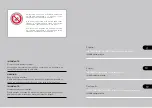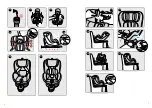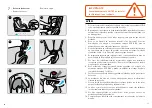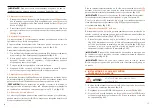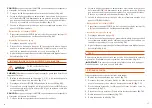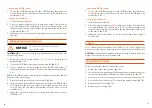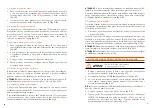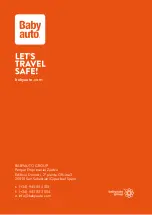
22
23
3.3. Harness straps adjustment
1. Pull the harness adjustment belt
(H)
o that the part of the strap that
covers the lap is not loose, ensuring the harness is taut and the buckle
closed. Open the harness buckle
(F)
by pressing the red button (fig.3.9).
2. Loosen the harness straps by pulling them at the point where they cover
the chest while pressing the harness adjustment button
(G)
(fig. 3.10).
3.4. Headrest adjustment
A correctly adjusted headrest
(F)
ensures that the diagonal part of the safety
belt is ideally positioned, offering the child the best possible protection.
The headrest should be adjusted so that a space equivalent to two fingers
remains between the headrest and the child’s shoulders(fig. 3.11).
To adjust the height of the headrest:
1. Pull the headrest height adjuster
(B)
and the headrest at the same time.
This will unlock the headrest (fig. 3.8).
2. Now you will be able to move the headrest to the desired height. When
the adjuster is released the headrest will remain locked in the chosen
position.
3. Place the safety seat on the car seat.
4. Sit the child in the seat and check the height. Repeat the process until
the correct height is achieved.
3.5. Recline positions adjustment
This child restraint system have five recline positions. Before installing
the child in the seat, select the reclining position by pulling of the lever
(I)
situated between the seat and the base.
CAUTION! In rearward facing, the only possible recline position is the R. In
fordward facing, you can select positions 1, 2, 3, or 4 (fig. 3.12).
3.6. Reductor cushion installation
Children whose age range is between birth and six months, can use the
reducer cushion
(D)
. This ensures that the child’s back is well protected
during the trip.
To install/uninstall the seat, open the harness buckle
(F)
by pressing the
harness red button. Separate the shoulder straps from the harness
(C)
to
facilitate the installation/removal of the reducer cushion (fig.3.13).
CAUTION! After the reducer cushion
(D)
is installed/uninstalled, remember
to adjust the harness straps following step 1 of point 3.3.
When the reductor cushion
(D)
is installed,fix the headrest cushion el cojín
passing the elastic belt behind the headrest (fig. 3.15) to get a correct
installation (fig. 3.16).
3.7. 360° function adjustment
The seat rotative system, allows to change between rearward facing
installation and forward facing installation, without uninstall the seat from
the vehicle (fig.3.17). For it:
1. Press the seat rotation locking button
(L)
while spin the seat (fig. 3.18).
Halfway through the route, it will lock again to adopt a position that
will facilitate the child’s installation in the seat (Figure 3.19). To continue
with the rotation movement, press the rotation lock button
(L)
again,
adapting the chair to the direction of travel (Fig. 3.20).
CAUTION! To change from forward facing installation to rearward facing
installation, remember to recline the seat to the 4 position (Fig. 3.21).
CAUTION! Always, try moving the seat in both directions to check that it is
correctly fixed to the vehicle.
4. REARWARD FACING INSTALLATION
45-87 cm. From birth to
2 years approx. (0-13 Kg)
NOTICE
1. Recline the seat to the R position. This is the only possible recline
position for rearward facing installation (fig. 4.1).
2. Unlock the ISOFIX arms
(M)
by pulling the strap
(O)
(fig. 4.2).
3. If your vehicle has not been fitted with the ISOFIX latch guides as
standard, fit the two latch guides
(S)
that came with the safety seat (fig.
4.3).
TIP: The ISOFIX fastening points are located between the surface and the
backrest of the vehicle seat.
5. Place the seat in the back seat of the vehicle (fig. 4.4).
6. Hold the safety seat with both hands and insert the two ISOFIX arms
(M) firmly into the insertion guides
(S)
until they fasten with a click
on both sides. The red button will partially change to green on both
sides(fig. 4.5).
7. Shake the seat to check that it is correctly anchored to the vehicle’s
ISOFIX points.


